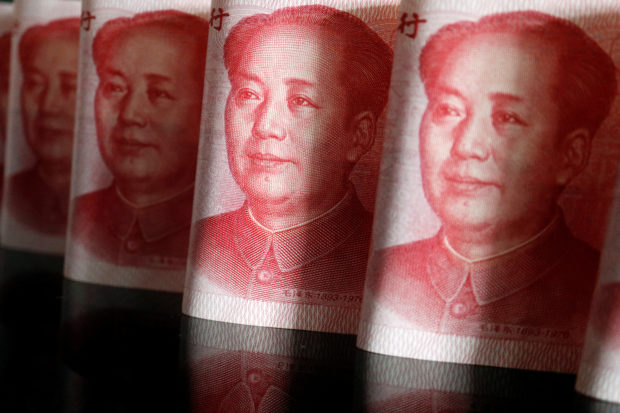Investment banks rush to cut yuan forecasts, 7 per dollar at risk

Chinese yuan banknotes are seen in this illustration picture taken April 25, 2022. REUTERS/Florence Lo/Illustration/File photo
SINGAPORE – Major investment houses have cut their yuan forecasts as its fall against the dollar accelerates, with some expecting a breach of the 7-per-dollar milestone before next month’s politically sensitive Party Congress despite authorities’ efforts to slow the slide.
The yuan weakened 2.7 percent to the dollar in the past three weeks, reaching a two-year low of 6.9350 on Monday, and is down more than 8 percent year to date, pressured both by the dollar’s global strength and by China’s worsening economic slowdown.
A quick break through 7 per dollar – breached only twice since the global financial crisis of 2008 – could stoke fears of capital outflows just as the authorities want to marshal resources to revive the economy, which is reeling from COVID-19 outbreaks and a weak property market.
It could also be an unwelcome distraction for leaders gathering from Oct. 16 for the Party Congress, held once every five years, although some analysts expect the authorities eventually to accept more yuan weakening.
“Over the three-month horizon, we expect policymakers to have higher tolerance for CNY depreciation as by that time the 20th Party Congress will have concluded and a weaker currency could help reduce headwinds to export growth,” Goldman Sachs said in a note.
Goldman Sachs and ANZ believe the 7-per-dollar mark will not be breached until after the Party Congress.
But others, including Nomura, MUFG and SEB, also see a chance for the yuan to hit the key threshold this month.
Market analysts widely believe the People’s Bank of China’s (PBOC) unexpected cuts to key interest rates in August speeded up the yuan’s fall, reaffirming Beijing as a global monetary policy outlier while most other major economies are tightening policy to tame inflation.
“(China’s policy) only underscores the weakness of the economy,” Maybank analysts said.
“As long as the zero-COVID policy (continues) and there is a lack of a significant turn around in the property sector, PBOC has to remain in easing mode,” they added. “Such an environment would be negative for the yuan.”
Maybank revised down its yuan forecast to 7 per dollar at end-Q3 and 6.95 at end-December, from 6.75 and 6.70 respectively in their previous forecast.
Ken Cheung, chief Asian FX strategist at Mizuho Bank, linked the yuan’s outlook explicitly to China’s economic growth outlook: “Market participants tend to long USD/CNY to hedge the macro risk for China.”
Authorities have indicated concern, however, over the latest rapid move lower. Reuters reported that China’s foreign exchange regulator phoned several banks in late August to warn them against aggressively selling the Chinese currency.
Consistently firmer-than-expected yuan midpoint fixings in the last two weeks are another clear sign that the authorities do not want to see a sharp drop at this time, said Irene Cheung, senior strategist for Asia at ANZ.
“This will help cap USD/CNY at the 6.9 handle in the near term. However, a breach of the 7 mark after the conclusion of the National Congress is possible,” she said.